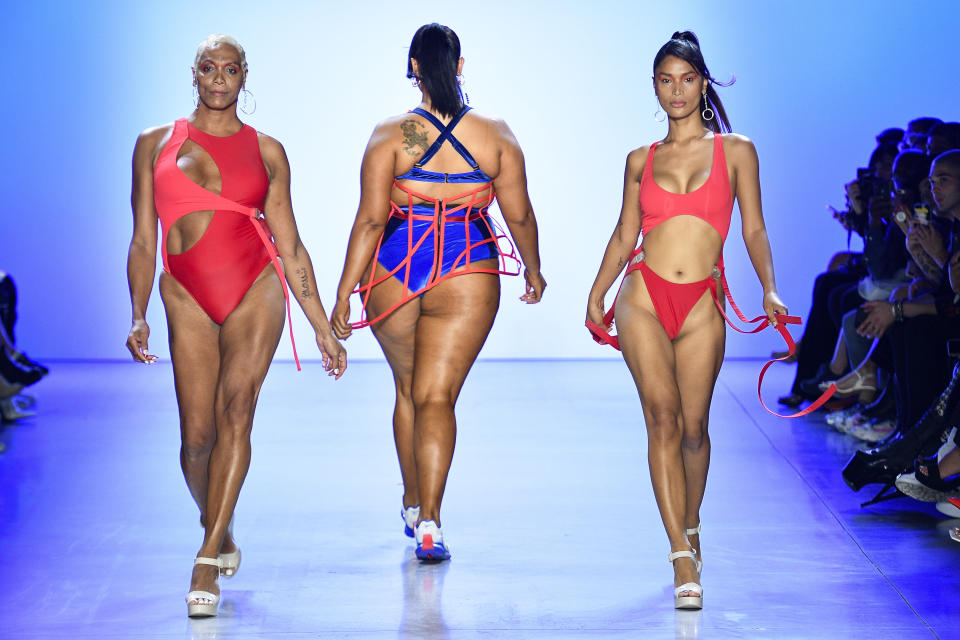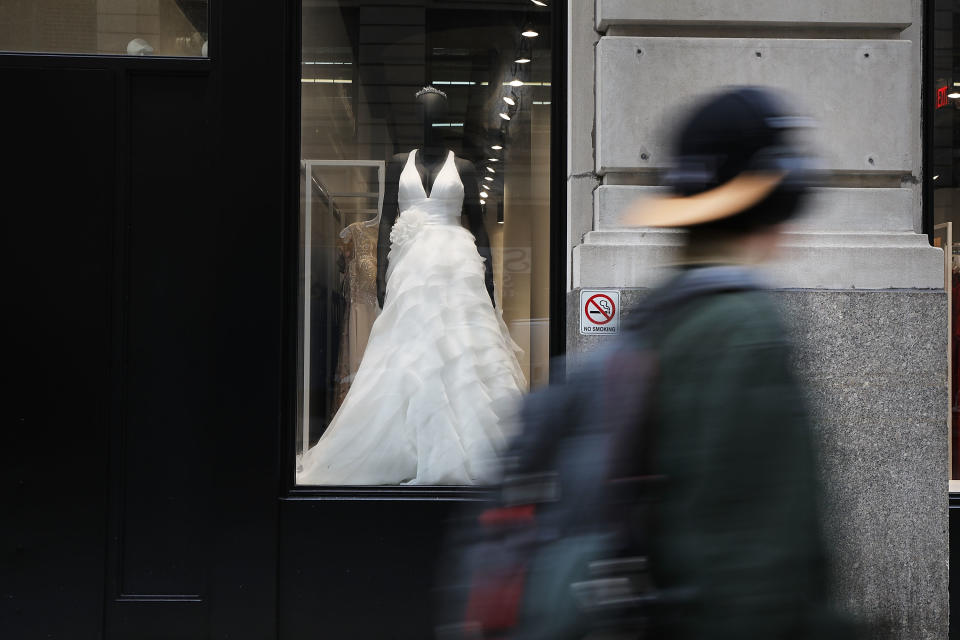2019's plus-size breakthroughs, from David’s Bridal ditching the ‘fat tax’ to curvy mannequins
2019 is coming to a close, ushering in a new decade full of possibilities for the fashion industry. And while there's still a lot of work to be done in terms of making size inclusivity mainstream, the past year has seen some major progress when it comes to brands embracing all body types.
That’s crucial, because, as a 2016 study from researchers Deborah A. Christel, PhD and Susan Dunn found, the average American woman no longer wears a size 14, a figure that has been cited since the 1990s. Their research found instead that she falls between a size 16 and 18, with a 37-38” waist. Therefore, “plus size” doesn’t necessarily describe clothing designed to be larger than the average woman; it is what the average woman is wearing.
Christel, who founded the size-inclusive Kade & Vos underwear range, tells Yahoo Lifestyle that, brands refusing to accommodate the 67 percent of American women who wear a size 14 or above will eventually fall by the wayside.
“We're seeing size-inclusive companies growing and seeing brands with limited sizing lose millions of dollars,” she says. “I think this is happening because people see that exclusion is not the answer. Both smaller and larger women are flocking to companies that offer a wide range of sizes. Fashion companies that don't expand their sizing may soon be out of business.
“With all the ways we are divided, fashion is one way we can be united together,” she adds. “There are no justifiable reasons to exclude plus sizes. Companies that exclude plus sizes reflect how they feel about large bodies, which ultimately stems from fat stigma.
“It's simple and the data speaks for itself; plus-size people need clothing just like everyone else and I believe the fashion industry has a moral obligation to provide more options.”
Which brands are getting it right? Read on to look back on some of the year’s most size-inclusive strides.
Savage X Fenty storms the runway

Although Rihanna launched her lingerie line in 2018, it was Savage X Fenty’s New York Fashion Week show this September — televised on Amazon Prime — that really put it on the map and opened up shoppers’ eyes to what a sexy, and size-inclusive brand could really be. “Created for the female gaze, not the male gaze,” according to its marketing copy, the affordable range offers bras running from 32A to 46DDD, plus bralettes, underwear and lingerie up to size 3X. Its diverse roster of models — including singer Normani, actress Laverne Cox and plus-size model Paloma Elsesser — doesn’t just represent curves; pregnant women, the trans community and amputees like the late Mama Cax have also been welcomed into the fold.
It’s hard to not feel like the downward spiral of Victoria’s Secret — which scrapped its own annual fashion show this year — is connected. One can only hope that Rihanna’s luxury line with LVMH, Fenty, will follow suit. It currently only runs up to a U.S. size 14, though the pop star did make a body-inclusive gesture by featuring mannequins with fuller figures at a New York City pop-up event.
Here for this mannequin having hip dips and a little pooch https://t.co/ybZyHFwrlm
— Tellie (@Chaantellie) June 19, 2019
Chromat switches up its sales

An issue that full-figured fashionistas are constantly encountering is an eye-wateringly expensive price tag, a.k.a. the “fat tax.” As technical design consultant Mariana Leung of Ms. FABulous tells Yahoo Lifestyle, clothing production costs can add up when brands are spending more on materials, research and development, resulting in inclusive looks that come at inaccessible price points.
This year, Chromat decided to turn the tide. While the swimwear brand has been praised for its range of sizes (XS-4X), its pricing kept its colorful, curve-hugging tank suits and bikinis out of reach for many admirers. In September — around the same time it included plus-size models Emme and Tess Holliday in its New York Fashion Week show — the brand announced its plan to cut costs by discontinuing its relationship with wholesalers.
“We didn't want to compromise our ethical production or quality materials, so we decided cutting out the wholesale markup was the best way to go,” a statement sharing the news read. “Moving forward, we will be reducing our retail price point so most swimsuits and sets are available for under $200.”
Leung says that the change shows how adapting a brand’s business model can help them prioritize customers of all shapes and sizes.
“Chromat's policy of inclusivity in sizing and casting now includes pricing accessibility,” she says. “They understood that a product that looks good and fits well across all bodies is only so successful if only a limited number of customers can afford it.”
Nike makes a major mannequin move
In June, Nike’s London flagship store introduced a plus-size mannequin, clad in a black sports bra and leggings, in a nod to its expanded range of larger sizes. The NikeTown location also rolled para-sport mannequins to represent shoppers with disabilities.
"To celebrate the diversity and inclusivity of sport, the space will not just celebrate local elite and grassroot athletes through visual content, but also show Nike plus-size and para-sport mannequins for the first time on a retail space," Nike said in a press release.
While many, including body-positive athletes, models and influencers, championed the display, one British writer had the opposite reaction. Writing for the Telegraph, Tanya Gold accused the brand of glorifying obesity and selling “women a dangerous lie” with its “immense, gargantuan, vast” mannequin. Gold’s criticisms sparked its own backlash, with many calling the journalist out for fat-shaming.
Tanya, with all due respect for your right to express yourself, NO. Yes, women of every size can AND DO run. And walk. And cycle. And dance. And yes, they deserve clothes just as nice as their skinnier sisters. Stop. Don’t shame and punish. Go for a run. You’ll feel better. @Nike https://t.co/A1ktQ3Qmxz
— Stormgrl (@stormgrl) June 10, 2019
11 Honoré brings curves to the catwalk

With a few exceptions, such as Christian Siriano and Badgley Mischka, luxury labels have left larger women out in the cold by limiting their size range. The designer plus-size e-tailer 11 Honoré has helped to fill that void by stocking sizes 12 to 24. In February, the company staged its first New York Fashion Week show, with the likes of actress Laverne Cox and model Candice Huffine gliding down the runway in curve-friendly designs from Zac Posen, Brandon Maxwell and more. With luck, the powers that be in Paris and Milan were paying attention.
David’s Bridal (finally) ditches its “fat tax”

It’s been five years since David’s Bridal — the go-to spot for brides on a budget — introduced mannequins with curves more in line with the average woman’s size. But it was only this past month that the retailer, which stocks up to size 30W, announced that it would cease charging plus-size brides more for their wedding gowns.
“Going forward, all brides and bridesmaids will pay the same price for the same style, regardless of the size,” new CEO Jim Marcum said in a statement in mid-December, Glamour reports. Marcum noted that plus-size brides can pay an average of nearly 15 percent more for their wedding gowns, a markup known as the “fat tax.”
Read More from Yahoo Lifestyle:
Ashley Graham is working to teach women how to embrace pregnancy — stretch marks and all
How Jazz Jennings, Chaz Bono and Caitlyn Jenner: How the last decade changed the way we see gender
How Rihanna's 'Savage X Fenty Show' shines a light on what ails Victoria's Secret
Follow us on Instagram, Facebook, Twitter and Pinterest for nonstop inspiration delivered fresh to your feed, every day.



